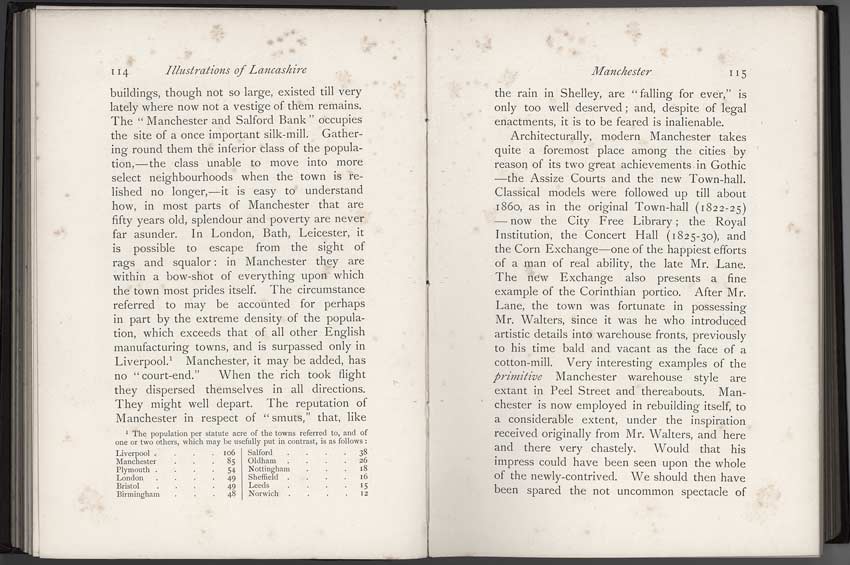
Scan and page transcript from:
LANCASHIRE - Brief Historical and Descriptive Notes
by Leo H. Grindon
Pub. 1892
pages 114-115 |
114 Illustrations of Lancashire buildings, though not so large, existed till very lately where now not a vestige of them remains. The "Manchester and Salford Bank" occupies the site of a once important silk-mill. Gathering round them the inferior class of the population, - the class unable to move into more select neighbourhoods when the town is relished no longer, - it is easy to understand how, in most parts of Manchester that are fifty years old, splendour and poverty are never far asunder. In London, Bath, Leicester, it is possible to escape from the sight of rags and squalor: in Manchester they are within a bow-shot of everything upon which the town most prides itself. The circumstance referred to may be accounted for perhaps in part by the extreme density of the population, which exceeds that of all other English manufacturing towns, and is surpassed only in Liverpool1 Manchester, it may be added, has no "court-end." When the rich took flight they dispersed themselves in all directions. They might well depart. The reputation of Manchester in respect of "smuts," that, like
|
Manchester 115 the rain in Shelley, are "falling for ever," is only too well deserved; and, despite of legal enactments, it is to be feared is inalienable, - Architecturally, modern Manchester takes quite a foremost place among the cities by l reason of its two great achievements in Gothic - the Assize Courts and the new Town-hall. Classical models were followed up till about 1860, as in the original Town-hall (1822-25) - now the City Free Library; the Royal Institution, the Concert Hall (1825-30), and the Corn Exchange - one of the happiest efforts of a man of real ability, the late Mr. Lane. The new Exchange also presents a fine example of the Corinthian portico. After Mr. Lane, the town was fortunate in possessing Mr. Walters, since it was he who introduced artistic details into warehouse fronts, previously to his time bald and vacant as the face of a cotton-mill. Very interesting examples of the primitive Manchester warehouse style are extant in Peel Street and thereabouts. Manchester is now employed in rebuilding itself, to a considerable extent, under the inspiration received originally from Mr. Walters, and here and there very chastely. Would that his impress could have been seen upon the whole of the newly-contrived. We should then have been spared the not uncommon spectacle of |
||||
